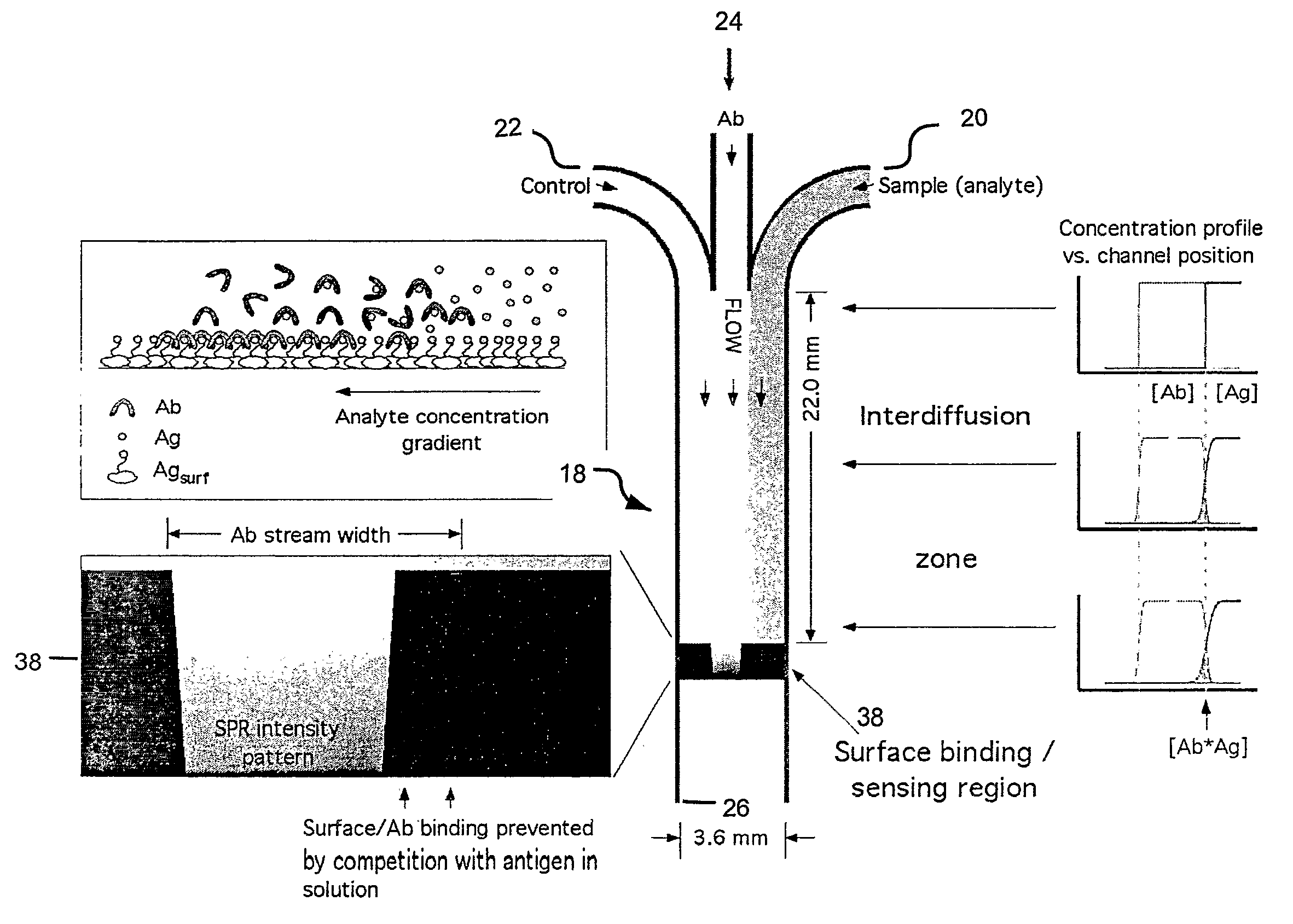Rapid Microfluidic Assay for Quantitative Measurement of Interactions Among One or More Analytes
a microfluidic and quantitative measurement technology, applied in the field of microfluidic competitive assay devices and assay methods, can solve the problems of adding additional reagent costs and labor, and achieve the effect of rapid quantitative measurement of interactions
- Summary
- Abstract
- Description
- Claims
- Application Information
AI Technical Summary
Benefits of technology
Problems solved by technology
Method used
Image
Examples
example i
[0056] As shown in FIG. 8, the immunoassay method of the present invention has been demonstrated experimentally by measuring two analytes in parallel at several regions in a single microfluidic channel. In such experiments, three streams are flowing parallel from the inlets to the outlet. As shown in FIG. 8, flow is from left to right. The first fluid stream comprises a buffer only and is included as a negative control. The second, middle fluid stream comprises a mixture of anti-cortisol and anti-estriol monoclonal antibodies (100 nM each) (shown as “MAbs”). The third fluid stream comprises a buffer with cortisol (50 nM) and estriol (100 nM) (shown as “C & E”). The sensing surface had been patterned with similar surface densities of BSA, BSA-cortisol conjugate (“BSA-C”), and BSA-estriot conjugate (“BSA-E”). The BSA / BSA conjugate triple pattern was repeated five times from left to right. The labels in FIG. 8 are positioned at the second repeated triplet. The gold coating was treated ...
example ii
[0058] One example of a non-limiting protocol of the present invention will now be described. A simplified flow chart illustrating the experimental protocol is provided in FIG. 9. At step 100, the gold coating of the microscope slide is cleaned. However, if the glass slides have been freshly evaporated (within the previous 60 minutes), the cleaning steps of the gold coating can be omitted. The gold coating may be cleaned in a hot base / peroxide wash In such a method, in a clean, flat-bottom glass dish, hydrogen peroxide, ammonium hydroxide, and ddH2O are mixed in a 1:1:5 volumetric ratio (e.g., 10 mL H202, 10 mL NH4OH, 50 mL ddH2O). The solution is heated to 65-75° C. and covered with a watch glass to minimize evaporative loss. The gold coated glass slide is immersed in the heated solution and soaked for approximately 10 minutes. The slide is removed and rinsed first with ddH2O then absolute ethanol. Finally, the slide is blow dried under a dry N2 stream. Other methods of cleaning th...
PUM
| Property | Measurement | Unit |
|---|---|---|
| length | aaaaa | aaaaa |
| height | aaaaa | aaaaa |
| height | aaaaa | aaaaa |
Abstract
Description
Claims
Application Information
 Login to View More
Login to View More - R&D
- Intellectual Property
- Life Sciences
- Materials
- Tech Scout
- Unparalleled Data Quality
- Higher Quality Content
- 60% Fewer Hallucinations
Browse by: Latest US Patents, China's latest patents, Technical Efficacy Thesaurus, Application Domain, Technology Topic, Popular Technical Reports.
© 2025 PatSnap. All rights reserved.Legal|Privacy policy|Modern Slavery Act Transparency Statement|Sitemap|About US| Contact US: help@patsnap.com



